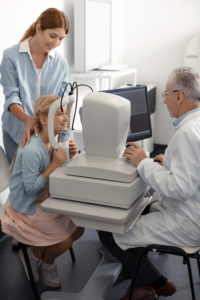sponsored content
August 15, 2022
By James Loughman, PhD, and Ian Flitcroft, DPhil
As we’re shifting from the conventional means of managing myopia, which was to simply manage symptoms with a pair of single vision glasses, contact lenses, or laser eye surgery, we’re transitioning into an evidence-based means of practicing and clinical decision-making.
 The public health importance of a comprehensive myopia management approach is becoming increasingly obvious. The potential benefits of delaying myopia onset and of early intervention once myopia is detected require that effective screening for pre-myopia and myopia should be in place from early age. In particular, children identified as being at increased risk (i.e., those with myopic parents), or those in the pre-myopic range, should be monitored frequently from age 6 or below to allow the earliest possible intervention. Repeat measurements from early age are of particular value for identifying pre-myopes and for monitoring those at risk of progression or determining treatment efficacy. How best to monitor such children is an important question. Refraction and axial length are the two critical data points in managing myopic patients. While we certainly believe in the importance of axial length, we would also argue that successful myopia management can be performed with just a patient’s Rx.
The public health importance of a comprehensive myopia management approach is becoming increasingly obvious. The potential benefits of delaying myopia onset and of early intervention once myopia is detected require that effective screening for pre-myopia and myopia should be in place from early age. In particular, children identified as being at increased risk (i.e., those with myopic parents), or those in the pre-myopic range, should be monitored frequently from age 6 or below to allow the earliest possible intervention. Repeat measurements from early age are of particular value for identifying pre-myopes and for monitoring those at risk of progression or determining treatment efficacy. How best to monitor such children is an important question. Refraction and axial length are the two critical data points in managing myopic patients. While we certainly believe in the importance of axial length, we would also argue that successful myopia management can be performed with just a patient’s Rx.
Importance of Rx
When practitioners are starting with myopia management, just using the patient’s refractive data is a reasonable starting point. Otherwise, mandating axial length measurements for myopia control creates a barrier so high that the majority of optometrists wouldn’t be able to participate in myopia management for a long time. There are too many young progressing myopes to be managed only by the limited number of eye care practitioners who currently have access to axial length measurement. To help the greatest number of myopic children, we don’t want to create artificial impediments to myopia control. The clinical trials of the currently available myopia control treatments have quite rightly validated their impact on both refraction and axial length. This allows practitioners to start in active myopia management based on just refraction until they can justify the substantial investment in optical biometry technology.
A patient’s Rx can also be incredibly beneficial when thinking about the conversation in the exam room with patients and parents. Patient and parent communication is the critical first step in myopia management. Suppose we’re talking about managing childhood myopia more proactively. In that case, one of the challenges is communicating effectively with parents and allowing them to interpret what their child’s prescription actually means.
Additionally, as an absolute metric, refraction is the most intuitive and easiest means to evaluate treatment efficacy. Once an eye becomes myopic the ideal annual rate of refraction should be zero, but targeting less than 0.25D/year progression. In clinical trials of myopia treatments, the majority of patients in the treated group fall below that threshold. A 50% reduction in the annual rate of progression compared to the year before treatment is a reasonable benchmark for a partial treatment success. In subsequent years, with the natural reduction in progression with age, the progression rate should slowly decline from that value.
We’ve done a lot of work recently involving centile charts, which are already available for axial length but are used less frequently for refraction. However, we’d argue they’re essential for refraction, too. Firstly, they are useful from a risk profiling perspective, using the child’s refraction at their particular age while also looking at that child’s sex and ethnic background to determine precisely what level of risk they’re exposed to. These charts show us how myopic children are relative to their peers, which is an important and powerful piece of information to communicate to a parent. From a treatment monitoring perspective, centile charts can provide the clearest indication of whether an intervention is working or not. Successful treatment should slow down progression relative to what would have been expected without treatment, thereby leading to a gradual reduction in a child’s centile position over time. Most parents are already familiar with such charts as their children would have been monitored on such charts by their pediatrician as babies, so it makes for a faster and easier explanation at every stage of treatment.
One of the issues that practitioners face is chair time and the fear of having a deep, long conversation. If you try to introduce axial length in that first conversation, there’s a lot of explaining to do. Our mantra is to convert a long, complicated conversation into a short, effective one. The primary factor we need to establish at the first visit is age and baseline refraction because they are the best predictor of future progression.
Getting More Specific with Axial Length
Axial length is being touted as the core metric for myopia management. In some ways, that’s undoubtedly true, but allowing a clinician to interpret that figure meaningfully is a challenge. Normal eyes are still growing quite fast at 6 years of age (0.20-0.25mm/year). The Collaborative Longitudinal Evaluation of Ethnicity and Refractive Error (CLEERE) study reported an axial growth rate of 0.33mm/year in the year before myopia onset. The rate of growth declines to less than 0.10mm per year by 12 years old. By 14-16 emmetropic eyes are still growing, but very slowly, 0.03mm/year to 0.06mm/year in girls. Despite this growth, most normal children will remain emmetropic due to the increase in axial length being balanced by reductions in lens power with age. We cannot, therefore, expect a zero growth rate among children on treatment; instead, the appropriate baseline is the growth expected in an emmetropic eye — this is still a growing child, after all. Interpreting this changing pattern of eye growth when using axial length measures in practice can be difficult, especially in younger children. Clinicians have to interpret key information including: what does an initial baseline axial length mean, and what does a degree of change in axial length over time, while on or not on treatment, mean for that individual child? This, again, is where centile curves can be helpful. These charts allow clinicians to understand an individual axial length value at a particular time for a specific child. It allows us to understand a child’s risk profile for future eye growth and determine their response to treatment once initiated (again, centile position should gradually decline with successful intervention).
One of the key takeaways with axial length is treatment prioritization. The longer the eyes are for a young child (which will be reflected with a higher centile position), the more the clinician should push to get that child started on treatment — without scaring them as to the potential consequences. Having a young child with a very long eye should concern clinicians. This child will likely experience continued axial growth into adulthood, potentially leading to much poorer vision later in life. The higher the initial axial length, the more aggressive you should be in treatment, as every extra 0.5mm carries a greater risk of subsequent visual impairment.
It’s also essential for practitioners to determine whether they’re dealing with a typical axial elongating myope. This is usually a pretty fair assumption in children and young adults. Still, if you start treatment and you’re not getting the results you’re expecting, you want to look at the whole biometric structure of the eye to determine the next steps. Other conditions such as early keratoconus, for example, can present with progressive myopia, which will not respond to myopia control treatment. When you’re able to measure the axial length, you can see that their eye probably isn’t growing any faster than an emmetropic child’s eye would be growing. That’s why looking at the eye as a whole — the corneal topography, the refraction, and the axial length — gives a much more complete understanding of the myopic eye.
Understanding Risks of Eye Growth
While measuring axial length gives practitioners a better understanding of a patient’s likelihood of developing eye health risks, one of our goals is to move away from the idea that there’s a specific threshold to aim for in terms of axial length. Though many experts point to 26mm as the threshold for serious risk factors, that figure correlates with the threshold for high myopia in adults. The issue is that a six-year-old child with an axial length of 25.5mm, for example, is probably destined to have an axial length greater than 27.5mm. So, this single number — 26mm — is a reasonably good match for an adult, but it’s not a great threshold in children because kids’ eyes are growing.
Additionally, though there are far more significant eye health risks to longer eyes, those risks don’t start at 26mm. If your axial length is 25mm, you are at higher risk than if your axial length is 24mm. Your risk worsens every millimeter that you go up from a normal axial length, which is about 24mm. Noel Brennan and Mark Bullimore came up with that great sound bite — every diopter matters. Concerning axial length, every millimeter matters, too, for precisely the same reason, so the goal of treatment should not be focused on any particular threshold but simply to eliminate abnormal myopic growth and keep the axial length as close to normal as possible.
Interventions are still necessary for patients who have already experienced excessive axial elongation. There is a dose-response relationship between refraction and axial length and the risk of eye disease and vision impairment. There is substantial evidence that individuals with longer eyes are particularly vulnerable to continued axial growth long into adulthood. Ultimately, every single step matters, and while myopia is still progressing, it is never too late to implement a comprehensive myopia management plan.
Estimating Axial Length
As we’re shifting from the conventional means of managing myopia, which was to simply manage symptoms with a pair of single vision glasses, contact lenses, or laser eye surgery, we’re transitioning into an evidence-based means of practicing and clinical decision-making. More information at their fingertips allows practitioners to make better-informed decisions for their patients, provided they have the tools to interpret and explain that information. An estimation of axial length, plus the refractive status, brings you additional clinically significant information you can use in your management. Risk profiling based on axial length is an excellent example of using this extra information. Even though every clinician cannot measure axial length, an estimated value can be very valuable.
We’ve shown in recent studies that our axial length estimator is 97% accurate at identifying children with the longest axial lengths (≥ 26mm). While axial length and refraction are correlated, using refraction alone is significantly less reliable as an indicator of which children are most at risk of complications associated with longer axial length. Having over 97% accuracy in detecting unusually long eyes is much better than just having the refractive data alone. This provides valuable information to the clinician that they can practically use in convincing patients and parents of the need for myopia control treatment.
Estimating axial length is also a great way to get clinicians comfortable with the idea of introducing axial length into clinical practice. Axial length estimation is, and we think should be, complementary to that drive toward getting eye care professionals into measuring axial length. It will increase their comfort levels with using axial length data to inform their clinical decision-making. Once they see the value of this additional data, they’ll be more comfortable deciding to invest in an optical biometer. Ultimately, we hope people will aspire to make that investment in the future. Still, we want them to start using as much data as they can now to make the best possible clinical decisions and work toward doing more to optimize health outcomes for every patient.
Human nature is such that the less daunting myopia control appears, the more likely you will adopt it in your practice. If practitioners can start with the basics, get comfortable with it, and see how they can improve their care by adding in axial length, then that’s progress. We think this should be part of all practitioners’ long-term plans, and as your practice and confidence develop, you’ll want to go even further.
This article is sponsored by EssilorLuxottica.

Ian Flitcroft, DPhil |

James Loughman, PhD |













